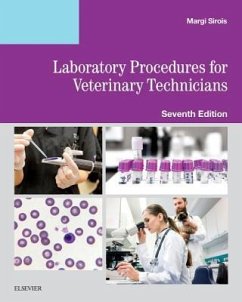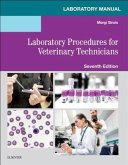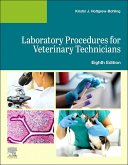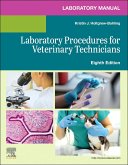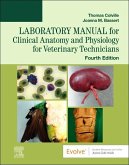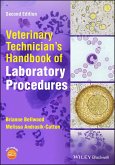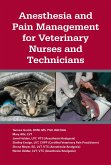Sirois, Margi, EdD, MS, RVT, LAT (Consultant)
Laboratory Procedures for Veterinary Technicians
Sirois, Margi, EdD, MS, RVT, LAT (Consultant)
Laboratory Procedures for Veterinary Technicians
- Broschiertes Buch
- Merkliste
- Auf die Merkliste
- Bewerten Bewerten
- Teilen
- Produkt teilen
- Produkterinnerung
- Produkterinnerung
This procedures guide for veterinary technicians provides step-by-step coverage of the most widely used laboratory workups for microbiology, hematology, immunology, urinalysis, parasitology, and cytology.--From publisher description.
Andere Kunden interessierten sich auch für
![Laboratory Manual for Laboratory Procedures for Veterinary Technicians Laboratory Manual for Laboratory Procedures for Veterinary Technicians]() Sirois, Margi, EdD, MS, RVT, LAT (Consultant)Laboratory Manual for Laboratory Procedures for Veterinary Technicians43,99 €
Sirois, Margi, EdD, MS, RVT, LAT (Consultant)Laboratory Manual for Laboratory Procedures for Veterinary Technicians43,99 €![Laboratory Procedures for Veterinary Technicians Laboratory Procedures for Veterinary Technicians]() ElsevierLaboratory Procedures for Veterinary Technicians97,99 €
ElsevierLaboratory Procedures for Veterinary Technicians97,99 €![Laboratory Manual for Laboratory Procedures for Veterinary Technicians Laboratory Manual for Laboratory Procedures for Veterinary Technicians]() ElsevierLaboratory Manual for Laboratory Procedures for Veterinary Technicians38,99 €
ElsevierLaboratory Manual for Laboratory Procedures for Veterinary Technicians38,99 €![Laboratory Manual for Clinical Anatomy and Physiology for Veterinary Technicians Laboratory Manual for Clinical Anatomy and Physiology for Veterinary Technicians]() Thomas P. Colville (Professor Emeritus Department of Animal SciLaboratory Manual for Clinical Anatomy and Physiology for Veterinary Technicians66,99 €
Thomas P. Colville (Professor Emeritus Department of Animal SciLaboratory Manual for Clinical Anatomy and Physiology for Veterinary Technicians66,99 €![Veterinary Technician's Handbook of Laboratory Procedures Veterinary Technician's Handbook of Laboratory Procedures]() Brianne Bellwood (Lakeland College, Alberta, Canada)Veterinary Technician's Handbook of Laboratory Procedures61,99 €
Brianne Bellwood (Lakeland College, Alberta, Canada)Veterinary Technician's Handbook of Laboratory Procedures61,99 €![Anesthesia and Pain Management for Veterinary Nurses and Technicians Anesthesia and Pain Management for Veterinary Nurses and Technicians]() Tamara L. GrubbAnesthesia and Pain Management for Veterinary Nurses and Technicians79,99 €
Tamara L. GrubbAnesthesia and Pain Management for Veterinary Nurses and Technicians79,99 €![Large Animal Clinical Procedures for Veterinary Technicians Large Animal Clinical Procedures for Veterinary Technicians]() Kristin J. Holtgrew-Bohling (Veterinary Technology Prog InstructorLarge Animal Clinical Procedures for Veterinary Technicians92,99 €
Kristin J. Holtgrew-Bohling (Veterinary Technology Prog InstructorLarge Animal Clinical Procedures for Veterinary Technicians92,99 €-
-
-
This procedures guide for veterinary technicians provides step-by-step coverage of the most widely used laboratory workups for microbiology, hematology, immunology, urinalysis, parasitology, and cytology.--From publisher description.
Hinweis: Dieser Artikel kann nur an eine deutsche Lieferadresse ausgeliefert werden.
Hinweis: Dieser Artikel kann nur an eine deutsche Lieferadresse ausgeliefert werden.
Produktdetails
- Produktdetails
- Verlag: Elsevier - Health Sciences Division
- 7 ed
- Seitenzahl: 433
- Erscheinungstermin: 21. Februar 2019
- Englisch
- Abmessung: 217mm x 276mm x 18mm
- Gewicht: 1240g
- ISBN-13: 9780323595384
- ISBN-10: 0323595383
- Artikelnr.: 54590066
- Herstellerkennzeichnung
- Libri GmbH
- Europaallee 1
- 36244 Bad Hersfeld
- gpsr@libri.de
- Verlag: Elsevier - Health Sciences Division
- 7 ed
- Seitenzahl: 433
- Erscheinungstermin: 21. Februar 2019
- Englisch
- Abmessung: 217mm x 276mm x 18mm
- Gewicht: 1240g
- ISBN-13: 9780323595384
- ISBN-10: 0323595383
- Artikelnr.: 54590066
- Herstellerkennzeichnung
- Libri GmbH
- Europaallee 1
- 36244 Bad Hersfeld
- gpsr@libri.de
Margi Sirois is certified as both a veterinary technician & laboratory animal technician and has over 25 years of experience as a veterinary technician educator in both traditional and distance education programs. She is a past-president of the Association of Veterinary Technician Educators and the Kansas Veterinary Technician Association and co-founder and current president of the Academy of Veterinary Technician Specialists in Education
UNIT 1: THE VETERINARY PRACTICE LABORATORY
1. Safety and OSHA Standards
2. General Laboratory Equipment
3. The Microscope
4. The Metric System and Lab Calculations
5. Quality Control and Record Keeping (UPDATED!)
UNIT 2: HEMATOLOGY
6. Hematopoeisis
7. Sample Collection and Handling
8. Automated Analyzers
9. Hemoglobin, PCV, and Erythrocyte Indices
10. Evaluating the Blood Film
11. Morphologic Abnormalities of Blood Cells
12. Additional Hematologic Tests
13. Hematopoeitic Disorders and Classification of Anemia
UNIT 3: HEMOSTASIS
14. Principles of Blood Coagulation
15. Sample Collection and Handling
16. Platelet Evaluation
17. Coagulation Testing
18. Disorders of Hemostasis
UNIT 4: IMMUNOLOGY (ENTIRE UNIT UPDATED!)
19. Basic Principles of Immunology
20. Common Tests Performed in the In-House Testing
21. Blood Groups and Immunity
22. Intradermal Testing
23. Reference Laboratory Tests
24. Disorders of the Immune System
UNIT 5: URINALYSIS
25. Anatomy and Physiology of the Urinary System
26. Sample Collection and Handling
27. Physical Examination of Urine
28. Chemical Evaluation
29. Urine Sediment Analysis
UNIT 6: CLINICAL CHEMISTRY
30. Sample Collection and Handling
31. Automated Analyzers
32. Protein Assays and Hepatobiliary Function Tests
33. Kidney Function Tests
34. Pancreatic Function Tests
35. Electrolyte and Acid-Base Status
36. Miscellaneous Tests
UNIT 7: MICROBIOLOGY
37. Introduction to Microbiology
38. Equipment and Supplies
39. Sample Collection and Handling
40. Staining Specimens
41. Culture Techniques
42. Antimicrobial Sensitivity Testing
43. Additional Testing
44. Mycology
UNIT 8: PARASITOLOGY
45. Nematodes
46. Cestodes, Trematodes, and Acantocephelans
47. Protozoa and Rickettsia
48. Arthropods
49. Sample Collection and Handling
50. Diagnostic Techniques
UNIT 9: CYTOLOGY
51. Sample Collection and Handling
52. Preparation of Cytology Smears
53. Microscopic Evaluation
54. Cytology of Specific Sites
Appendix A: Chapter Review Questions by Unit
Appendix B: Reference Ranges
Appendix C: Bacterial Pathogens of Veterinary Importance
Appendix D: Professional Associations Related to Veterinary Clinical
Laboratory Diagnostics
Appendix E: Common Parasites of Some Exotic Animal Species
1. Safety and OSHA Standards
2. General Laboratory Equipment
3. The Microscope
4. The Metric System and Lab Calculations
5. Quality Control and Record Keeping (UPDATED!)
UNIT 2: HEMATOLOGY
6. Hematopoeisis
7. Sample Collection and Handling
8. Automated Analyzers
9. Hemoglobin, PCV, and Erythrocyte Indices
10. Evaluating the Blood Film
11. Morphologic Abnormalities of Blood Cells
12. Additional Hematologic Tests
13. Hematopoeitic Disorders and Classification of Anemia
UNIT 3: HEMOSTASIS
14. Principles of Blood Coagulation
15. Sample Collection and Handling
16. Platelet Evaluation
17. Coagulation Testing
18. Disorders of Hemostasis
UNIT 4: IMMUNOLOGY (ENTIRE UNIT UPDATED!)
19. Basic Principles of Immunology
20. Common Tests Performed in the In-House Testing
21. Blood Groups and Immunity
22. Intradermal Testing
23. Reference Laboratory Tests
24. Disorders of the Immune System
UNIT 5: URINALYSIS
25. Anatomy and Physiology of the Urinary System
26. Sample Collection and Handling
27. Physical Examination of Urine
28. Chemical Evaluation
29. Urine Sediment Analysis
UNIT 6: CLINICAL CHEMISTRY
30. Sample Collection and Handling
31. Automated Analyzers
32. Protein Assays and Hepatobiliary Function Tests
33. Kidney Function Tests
34. Pancreatic Function Tests
35. Electrolyte and Acid-Base Status
36. Miscellaneous Tests
UNIT 7: MICROBIOLOGY
37. Introduction to Microbiology
38. Equipment and Supplies
39. Sample Collection and Handling
40. Staining Specimens
41. Culture Techniques
42. Antimicrobial Sensitivity Testing
43. Additional Testing
44. Mycology
UNIT 8: PARASITOLOGY
45. Nematodes
46. Cestodes, Trematodes, and Acantocephelans
47. Protozoa and Rickettsia
48. Arthropods
49. Sample Collection and Handling
50. Diagnostic Techniques
UNIT 9: CYTOLOGY
51. Sample Collection and Handling
52. Preparation of Cytology Smears
53. Microscopic Evaluation
54. Cytology of Specific Sites
Appendix A: Chapter Review Questions by Unit
Appendix B: Reference Ranges
Appendix C: Bacterial Pathogens of Veterinary Importance
Appendix D: Professional Associations Related to Veterinary Clinical
Laboratory Diagnostics
Appendix E: Common Parasites of Some Exotic Animal Species
UNIT 1: THE VETERINARY PRACTICE LABORATORY
1. Safety and OSHA Standards
2. General Laboratory Equipment
3. The Microscope
4. The Metric System and Lab Calculations
5. Quality Control and Record Keeping (UPDATED!)
UNIT 2: HEMATOLOGY
6. Hematopoeisis
7. Sample Collection and Handling
8. Automated Analyzers
9. Hemoglobin, PCV, and Erythrocyte Indices
10. Evaluating the Blood Film
11. Morphologic Abnormalities of Blood Cells
12. Additional Hematologic Tests
13. Hematopoeitic Disorders and Classification of Anemia
UNIT 3: HEMOSTASIS
14. Principles of Blood Coagulation
15. Sample Collection and Handling
16. Platelet Evaluation
17. Coagulation Testing
18. Disorders of Hemostasis
UNIT 4: IMMUNOLOGY (ENTIRE UNIT UPDATED!)
19. Basic Principles of Immunology
20. Common Tests Performed in the In-House Testing
21. Blood Groups and Immunity
22. Intradermal Testing
23. Reference Laboratory Tests
24. Disorders of the Immune System
UNIT 5: URINALYSIS
25. Anatomy and Physiology of the Urinary System
26. Sample Collection and Handling
27. Physical Examination of Urine
28. Chemical Evaluation
29. Urine Sediment Analysis
UNIT 6: CLINICAL CHEMISTRY
30. Sample Collection and Handling
31. Automated Analyzers
32. Protein Assays and Hepatobiliary Function Tests
33. Kidney Function Tests
34. Pancreatic Function Tests
35. Electrolyte and Acid-Base Status
36. Miscellaneous Tests
UNIT 7: MICROBIOLOGY
37. Introduction to Microbiology
38. Equipment and Supplies
39. Sample Collection and Handling
40. Staining Specimens
41. Culture Techniques
42. Antimicrobial Sensitivity Testing
43. Additional Testing
44. Mycology
UNIT 8: PARASITOLOGY
45. Nematodes
46. Cestodes, Trematodes, and Acantocephelans
47. Protozoa and Rickettsia
48. Arthropods
49. Sample Collection and Handling
50. Diagnostic Techniques
UNIT 9: CYTOLOGY
51. Sample Collection and Handling
52. Preparation of Cytology Smears
53. Microscopic Evaluation
54. Cytology of Specific Sites
Appendix A: Chapter Review Questions by Unit
Appendix B: Reference Ranges
Appendix C: Bacterial Pathogens of Veterinary Importance
Appendix D: Professional Associations Related to Veterinary Clinical
Laboratory Diagnostics
Appendix E: Common Parasites of Some Exotic Animal Species
1. Safety and OSHA Standards
2. General Laboratory Equipment
3. The Microscope
4. The Metric System and Lab Calculations
5. Quality Control and Record Keeping (UPDATED!)
UNIT 2: HEMATOLOGY
6. Hematopoeisis
7. Sample Collection and Handling
8. Automated Analyzers
9. Hemoglobin, PCV, and Erythrocyte Indices
10. Evaluating the Blood Film
11. Morphologic Abnormalities of Blood Cells
12. Additional Hematologic Tests
13. Hematopoeitic Disorders and Classification of Anemia
UNIT 3: HEMOSTASIS
14. Principles of Blood Coagulation
15. Sample Collection and Handling
16. Platelet Evaluation
17. Coagulation Testing
18. Disorders of Hemostasis
UNIT 4: IMMUNOLOGY (ENTIRE UNIT UPDATED!)
19. Basic Principles of Immunology
20. Common Tests Performed in the In-House Testing
21. Blood Groups and Immunity
22. Intradermal Testing
23. Reference Laboratory Tests
24. Disorders of the Immune System
UNIT 5: URINALYSIS
25. Anatomy and Physiology of the Urinary System
26. Sample Collection and Handling
27. Physical Examination of Urine
28. Chemical Evaluation
29. Urine Sediment Analysis
UNIT 6: CLINICAL CHEMISTRY
30. Sample Collection and Handling
31. Automated Analyzers
32. Protein Assays and Hepatobiliary Function Tests
33. Kidney Function Tests
34. Pancreatic Function Tests
35. Electrolyte and Acid-Base Status
36. Miscellaneous Tests
UNIT 7: MICROBIOLOGY
37. Introduction to Microbiology
38. Equipment and Supplies
39. Sample Collection and Handling
40. Staining Specimens
41. Culture Techniques
42. Antimicrobial Sensitivity Testing
43. Additional Testing
44. Mycology
UNIT 8: PARASITOLOGY
45. Nematodes
46. Cestodes, Trematodes, and Acantocephelans
47. Protozoa and Rickettsia
48. Arthropods
49. Sample Collection and Handling
50. Diagnostic Techniques
UNIT 9: CYTOLOGY
51. Sample Collection and Handling
52. Preparation of Cytology Smears
53. Microscopic Evaluation
54. Cytology of Specific Sites
Appendix A: Chapter Review Questions by Unit
Appendix B: Reference Ranges
Appendix C: Bacterial Pathogens of Veterinary Importance
Appendix D: Professional Associations Related to Veterinary Clinical
Laboratory Diagnostics
Appendix E: Common Parasites of Some Exotic Animal Species

